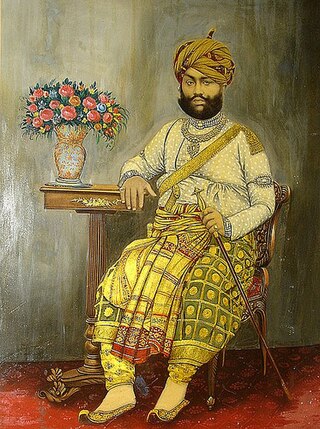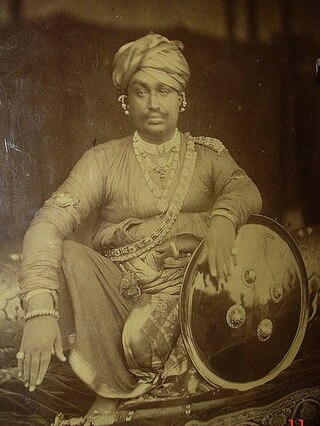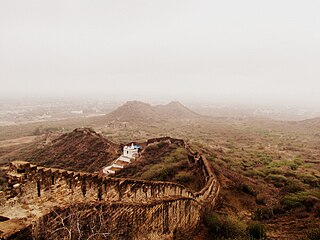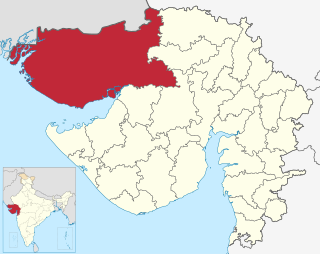
Bhuj is a Municipality and District Headquarters of Kutch District in the state of Gujarat, India.

Anjar is a town, township and municipality of the Kachchh district in the state of Gujarat, India. Founded in 650 AD, Anjar is a culturally diverse town of historic importance in the region. It is home to several historic religious temples, including the Jesal-Toral Shrines built in honour of a fourteenth century couple, whose lives inspired works of art and cinema. The town was devastated by several earthquakes, including the 1819 Rann of Kutch earthquake and 2001 Gujarat earthquake. In recent years, Anjar has become a hub of manufacturing activity.
Varnu is a village in Rapar Taluka in Kutch district of Gujarat, India. The village is on the west bank of Little Rann of Kutch.

Maharao Pragmalji II, (1839−1875) was the Rao of Cutch, a ruler of Jadeja dynasty who ascended the throne upon death of his father & king Rao Deshalji II on 26 July 1860 and ruled till his death on 19 December 1875.

Maharajadhiraj Mirza Maharao Shri Deshalji II Sahib Bahadur was the Rao of Cutch belonging to Jadeja dynasty, who ascended the throne of Princely State of Cutch upon deposition of his father Bharmalji II by British. He reigned during his minority, under a Council of Regency, headed by Captain MacMurdo and composed of Jadeja chiefs.
Tera is a historic village in the Kutch District of the Indian state of Gujarat. It is in Abdasa Taluka, located 13 kilometres (8.1 mi) from the taluka headquarters, Naliya, and 84 kilometres (52 mi) from the district headquarters, Bhuj.
Tera Fort is one of the many forts of Kutch, Gujarat, India. It is situated in southwestern Kutch near the village of Tera in Abdasa Taluka.

Bhujia Fort, also spelled as Bhujiya Fort, is a fort located in the outskirts of the town of Bhuj in the district of Kutch, Gujarat, India. The fort is built atop Bhujia Hill overlooking the town.

Cutch, also spelled Kutch or Kachchh and also historically known as the Kingdom of Kutch, was a kingdom in the Kutch region from 1147 to 1819 and a princely state under British rule from 1819 to 1947. Its territories covered the present day Kutch region of Gujarat north of the Gulf of Kutch. Bordered by Sindh in the north, Cutch State was one of the few princely states with a coastline.
Adesar is a small village in Kutch district, Gujarat, India.

Vira is a village in Anjar Taluka in Kutch district of Gujarat, India. Nearby temple of Jogninar is place of religious significance.
Maharajadhiraj Mirza Maharao Bharmalji II was the Rao of Cutch belonging to Rajput dynasty, who ascended the throne of Princely State of Cutch one month after the death of his father Rayadhan III.
Rao Rayadhan III was the Rao of Cutch belonging to Jadeja Rajput dynasty, who ascended the throne of Princely State of Cutch in 1778 and ruled until 1786 when he was deposed. He again ruled as titular head under council of Bar Bhayat ni Jamat from 1801 to 1813.
Bar Bhayat ni Jamat was a council of twelve members which managed Cutch State under titular kings Prithvirajji from 1786 to 1801 and under Rayadhan III from 1801 to 1813. The council was chiefly led by Fateh Muhammad during both period. The council is also known as Bar Bhayyat or Bar Bhaya.

Fateh Muhammad was a regent who administered Cutch State as a leader of Bar Bhayat ni Jamat under titular kings, Prithvirajji and Rayadhan III.
Rao Godji II, was the Rao of Cutch belonging to Jadeja Rajput dynasty, who ascended the throne of Princely State of Cutch in 1760 and ruled until 1778 when he died. During his rein, the state was invaded by Kalhoras and Talpuras of Sindh several times.
Rao Deshalji I was the Rao of Cutch belonging to Jadeja Rajput dynasty, who ruled Princely State of Cutch as a regent from 1718 1752. His son Lakhpatji confined him in 1741 and ruled as a regent until death of Deshalji in 1752.

The history of Kutch, a region in the extreme west of the western Indian state of Gujarat, can be traced back to prehistorical times. There are several sites related to Indus valley civilization in region and is mentioned in Hindu mythology. In historical times, Kutch is mentioned in Greek writings during Alexander. It was ruled by Menander I of Greco-Bactrian Kingdom which was overthrown by Indo-Scythians followed by Maurya Empire and Sakas. in the first century, it was under Western Satraps followed by Gupta Empire. By fifth century, Maitraka of Valabhi took over from which its close association with ruling clans of Gujarat started. Chavdas ruled the eastern and central parts by seventh century but then came under Chaulukyas by tenth century. After fall of Chaulukya, Vaghelas ruled the state. Following conquest of Sindh by Muslim rulers, Rajput Samma started moving southwards to Kutch and ruled western regions initially. By tenth century, they controlled significant area of Kutch and by thirteenth century they controlled whole of Kutch and adopted a new dynastic identity, Jadeja.
Santalpur is a village in Santalpur Taluka of Patan district of Gujarat state, India.

Bhujia Hill or Bhujiyo Dungar is a hill located in the outskirts of the town of Bhuj in the district of Kutch, Gujarat, India. The Bhujia Fort built on the hill overlooks the town.










